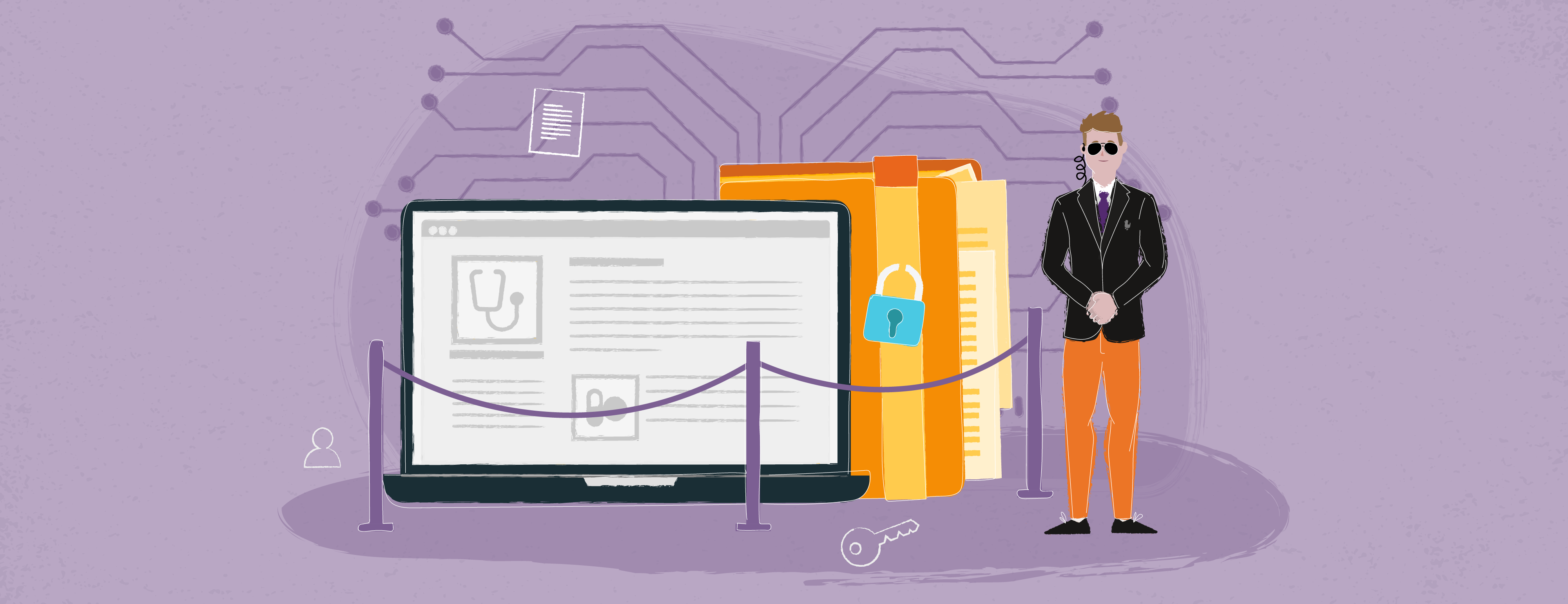Putting Privacy First: How Healthcare Companies Can Embrace Privacy by Design in Digital Transformation
Think of your intimate health stats being as secure as a top-secret mission file, untouched by any form of cyber threat or data debacle. That’s the essence of Privacy by Design, a pioneering principle that integrates privacy into the very DNA of healthcare systems and processes.
In this era of healthcare and digital transformation, adopting Privacy by Design is crucial for healthcare organizations as they navigate the challenges of content distribution, secure system integration, AI and ML, and cloud storage.

What is Privacy by Design?
Privacy by Design is a user-centric framework that helps developers and system engineers implement privacy and data protection as a core functionality – from the planning process to the subsequent implementation – of software, technology and wider systems.
It consists of seven principles:
- Proactive, not reactive; preventative, not remedial – systems are designed with security practice privacy in mind from the start, rather than adding security measures as an add-on.
- Privacy by default – no individual intervention is required because systems are designed with privacy in mind.
- Privacy embedded – it is an integral part of the system architecture
- Full functionality – positive sum, not zero-sum approach. The Privacy by Design approach seeks to satisfy all requirements and avoids compromising privacy with other objectives.
- End to end security top-to-end protection – data is protected from the moment it is collected until it is removed from the system.
- Transparency – the organization’s actions are clear to all stakeholders.
- Respect for consumer privacy – systems and services are designed with the user’s privacy in mind.
The term “privacy by design” was created by Anna Cavoukian, the Information and Privacy Commissioner of Ontario (IPC) in the 1990s. And while that’s a long time ago in a country far, far away, it still wraps and defines common goals found in all sectors – perhaps more so in areas where data privacy is of the utmost concern, such as healthcare. In fact, traces of it can be found in various data protection laws around the world, including GDPR, so its importance cannot be overstated.
Digital Healthcare Transformation and Privacy by Design
The digital healthcare transformation landscape is rapidly evolving, with technology playing an increasingly important role in the way organizations both manage and deliver patient care. For industry leaders, acceleration is happening at such a strong pace that it will undoubtedly rival sectors that embraced digitalization much sooner.
Thanks to electronic health records, telemedicine, AI-driven diagnostics, and other digital solutions in healthcare, companies can improve patient outcomes, streamline operations, and enhance overall efficiency. That much is obvious.
However, the widespread adoption of digital healthcare solutions also introduces new risks and challenges related to user privacy and security. Privacy by Design plays a critical role in this transformation. Organizations must implement technical and organizational measures to ensure that privacy and security concerns are addressed properly when implementing new digital healthcare solutions. By embedding privacy practices into technology design from the outset, healthcare organizations can mitigate security risks, maintain compliance with regulations, and ensure the trust and confidence of their patients.
What Technologies Can Support Privacy by Design?
Of course, talking about technologies is hardly useful. Now we’ve covered what Privacy by Design means and how it relates to the transformation challenges afflicting the healthcare sector, we can have focus on key example solutions. Let’s go through some of the most common – and most beneficial – examples.
Headless CMS: Versatile Content Management for Digital Healthcare
A headless CMS is a content management system that separates the presentation layer from the data and logic layer, allowing organizations to distribute content across multiple platforms without putting sensitive data at risk. In the context of digital healthcare transformation, healthcare organizations can leverage a headless CMS for a variety of purposes, including:
- Creating and managing websites for healthcare providers, hospitals, and clinics
- Sharing educational materials, such as blog posts, articles, and videos, to inform patients about health conditions, treatments, and preventive measures
- Executing promotional efforts, like email campaigns and social media updates, to raise awareness about healthcare services and events
It’s crucial to remember that a headless CMS is not designed for data collection or intake, and healthcare companies must use other secure digital solutions in healthcare to handle sensitive patient information.

We can highly recommend companies invest in secure web forms, encrypted databases and compliant storage systems – and ensure that the CMS is not connected to them at all. That’s why the headless approach is so valuable in this situation.
System Integration: Digital Healthcare Solutions
While we said that a headless CMS shouldn’t be interfacing with more sensitive systems, it is also true that those other systems might need to connect with each other. This is another place where we can look to proper, security-focused system integration in line with Privacy by Design principles.
Connecting various software, devices, and platforms to streamline operations, improve data sharing, and enhance patient care. Examples of systems that may be integrated as part of a digital healthcare transformation include:
- Electronic Health Record (EHR) systems to share patient data securely between healthcare providers, improving care coordination and reducing the risk of medical errors.
- Laboratory Information Systems (LIS) to manage and exchange lab results and test data, helping healthcare providers make informed decisions about patient care.
- Medical imaging systems (e.g., PACS) for sharing and storing diagnostic images, facilitating collaboration among specialists and improving diagnostic accuracy.
- Practice management systems for efficient scheduling, billing, and administrative tasks, reducing administrative burdens and allowing healthcare providers to focus on patient care.
By integrating these systems securely, healthcare organizations can create a seamless flow of information, optimize resource utilization, and enhance the overall patient experience. And even if you struggle with legacy systems, it’s still possible to integrate them safely with newer solutions.
However, such an integration shouldn’t be a data free for all. The flow of information should be highly engineered and scrutinized, with roles and permissions clearly implemented for each solution.
MACH and Composable Architecture
On the topic of integration, it’s also highly recommended that healthcare companies utilize a MACH (Microservices, API, Cloud-First, Headless) architectural approach. Composable architecture (as in Composable Commerce and focused very much on microservices in a MACH-like environment) is also a viable option, and so we are mentioning both here.
This is a suitable option as it enables companies to focus each individual microservice or solution to its own specific need, thus limiting data exposure at every step and meeting many of the key privacy by design principles.
For example, a healthcare provider website or portal might utilize a headless CMS for displaying content, and a separate service for enabling users to make appointments and bookings… but neither of these would have access to EHR medical records or other sensitive data. This would enable the respective teams to do fully realize their duties, without risking any potential data leaks or even the potential of accessing such data in the first place – assuming, as we said near the start, that the actual data storage is secured and engineered to a very high level.
This is where the integration layer would be an essential component. Such integration needs to ensure that data can flow between the relevant points, but it is not openly available everywhere.
Data Minimization and Anonimization
Speaking of information access, data minimization is a key principle of Privacy by Design. It is emphasizing the importance of collecting, storing, and processing the least amount of personal data needed for a specific purpose. In the context of AI and ML in healthcare, data minimization techniques can include:
- Removing unnecessary personal identifiers from data sets, reducing the risk of re-identification and potential privacy breaches.
- Using synthetic data or data aggregation to reduce the risk of identification of data subject while preserving the statistical utility of the data for research and analysis purposes.
- Implementing “differential privacy” techniques to add statistical noise to data, protecting individual privacy while maintaining data utility for AI and ML applications.
Needless to say – but let’s say it anyway 😉 – that high-level data engineering process is essential. There are too many systems, needs and use cases to underinvest in data engineering. From secure data storage to ensuring role-based access at all levels of the company, the correct implementation of data system and whole engineering process will ensure not only data protection, but that organizations themselves aren’t exposed to unnecessary data risks.
What’s more, by adopting these data minimization techniques, healthcare organizations can leverage the power of AI and ML while still safeguarding patient privacy. We won’t lie to you – these more advanced technologies can bring many benefits, but only when built on solid and secure foundations.
Challenges in the Cloud: Navigating International Data Storage
Storing patient data in the cloud presents legal challenges, particularly when data is stored on servers outside the organization’s home country. Different countries have their own rules regarding where such servers are held, but ultimately, there’s one clear common connection: using a public cloud does not free the initial company from the legal obligations of securing personal data.
Consequently, while the cloud can provide an ideal and flexible storage solution, it must be highly secured and protected. Healthcare companies must consider several factors when navigating the complexities of international data storage:
- Data protection regulations in both the home country and the country where the cloud server is located, ensuring compliance with all applicable data protection principles, laws and standards.
- Cross-border data transfer restrictions, such as those imposed by the General Data Protection Regulation (GDPR) in the European Union.
- Compliance with industry-specific regulations like the Health Insurance Portability and Accountability Act (HIPAA) in the United States or the Personal Information Protection and Electronic Documents Act (PIPEDA) in Canada.
It should come as no surprise to learn that careful and due consideration must be taken before moving to the Cloud. If you’re using a composable or microservice-based solution, you might be able to migrate the non-sensitive information first, such as the CMS or non-patient related backend services. However, when it comes to patient intake and medical data, healthcare organizations first need to carefully evaluate their cloud storage providers and develop their own data and management policies that align with the legal requirements of all relevant jurisdictions.
Taking the First Steps Towards Privacy by Design in Digital Healthcare
In an ideal world, Privacy by Design would have been implemented from day one. In reality, most healthcare organizations didn’t tackle digital security as their key concern when first getting set-up. For the most established of companies, this is primarily for the reason that such technology barely existed at the time.

So, instead, we should look at how to best implement Privacy by Design principles moving forward, and take strong security measures.
To begin implementing Privacy by Design in digital healthcare transformation, healthcare organizations should:
- Conduct a privacy impact assessment (PIA) to identify potential privacy risks and vulnerabilities in existing digital healthcare solutions, evaluating the potential impact of privacy breaches on patients and the organization.
- Collaborate with privacy experts, legal advisors, and stakeholders to develop a comprehensive privacy and security strategy for digital healthcare transformation, ensuring all aspects of the organization’s operations are considered.
- Embed privacy considerations into the design, development, and procurement of new technologies and systems, working with vendors and partners to establish privacy requirements and specifications.
- Implement strong access controls, encryption measures, and incident response plans to protect patient data and respond effectively to potential breaches.
- Regularly review and update privacy policies and business practices, to stay current with evolving threats, regulations, and industry standards, engaging in continuous improvement and adapting to emerging challenges.
Privacy by Design is an Essential Concept for Healthcare
Healthcare organizations can proactively address privacy concerns and better protect patient data, comply with regulations, and maintain patient trust. As healthcare companies navigate the challenges of content distribution, data processing activities, secure system integration, AI and ML implementation, and cloud storage in digital healthcare solutions, embracing Privacy by Design will ensure the highest standards of data privacy protection and security.
By taking the necessary steps to incorporate Privacy by Design principles, healthcare organizations can confidently move forward in their digital transformation journey, enhancing patient care and driving innovation in the industry.







